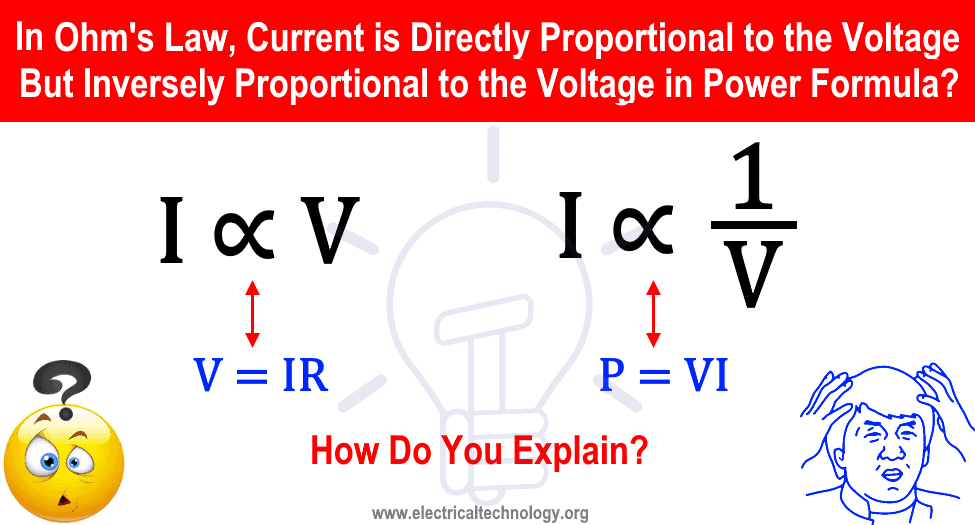In I = V ÷ R, Current is Directly Proportional to the Voltage, But Current is Inversely Proportional to the Voltage in P = V × I?
This is another confusing question mostly asked in electrical and electronics engineering interviews as is follow.
According to Ohm’s Law, Current Increases when Voltage increases (I=V ÷ R), but Current decreases when Voltage increases according to (P = V × I) formula. How do you explain?
i.e.
- According to Ohm’s Law: I ∝ V (Current directly proportional to the Voltage. I = V ÷ R)
- According to Power Formula: I ∝ 1 ÷ V (Current is inversely proportional to the Voltage. I = P ÷ V)
In short, according to the Ohm’s Law (V = I × R or I = V ÷ R) which shows that Current is directly proportional to the Voltage, but according to P = V × I or I = P ÷ V, it shows that Current is inversely proportional to the Voltage.
Let’s clear the confusion about the statement.
P = V × I
Actually, it depends on how you increase the parameters i.e. if you increase the voltage by keeping the power of the source constant or is it varying.
- If the power of the source is constant then the current would decrease when voltage increases.
- If you don’t care about the power and just simply replace the battery with a new one’s with higher power rating this can increase the current when voltage increase as power is no more constant i.e. power has been also increased.
In case of transformer, when voltage increases then current decrease because power remains constant i.e. both side power is P = VI (neglecting the power factor: Cos θ).
V = I × R
By Ohm’s Law, Current (I) is directly proportional to the Voltage (V) if Resistance (R) and Temperature remain constant.
- V = I × R
- R = V ÷ I
- I = V ÷ R
According the power formula, It says that Current is inversely proportional to the voltage if power remain same.
- P = V × I
- I = P ÷ V
- V = P ÷ I
As we already know that in a step-up transformer, if voltage increases, the current decreases where power is same (as transformer only step-up or step-down the value of current and voltage and doesn’t change the value of power). Similarly, voltage decreases when current increases in a step-down transformer.
The same story is there at the generating station where power generation is constant. If power at generation side improves, both current and voltage will be increased.
In short:
- If power is constant = Voltage is Inversely proportional to the Current i.e. V ∝ 1 ÷ I in P = V × I.
- If resistance and Temperature are constant: Voltage is directly proportional to the Current i.e. V ∝ I in V = I × R.
That’s is the exact reason why in Ohm’s Law, Current is Directly Proportional to the Voltage But Inversely Proportional to the Voltage in Power formula.
Related Questions/Answers:
- Is it Possible to Operate a 50Hz Transformer on 5Hz or 500Hz Frequency?
- Which Transformer is More Efficient When Operates on 50Hz or 60Hz?
- Can We Operate a 60Hz Transformer on 50Hz Supply Source and Vice Versa?
- Is Lightning AC or DC ?
- Why Transformer Does not Work on DC Supply instead of AC?
- In a Capacitive Circuit, Why the Current Increases When Frequency Increases?
- In an Inductive Circuit, Why the Current Increases When Frequency Decreases?
- Why Power Factor Decreases When Inductance or Inductive Reactance Increases?
- Why Power Factor Decreases When Capacitive Reactance Increases or Capacitance Decreases?

 Why is the Neutral Prong or Slot Wider on a Plug or Outlet?
Why is the Neutral Prong or Slot Wider on a Plug or Outlet? Why are there Grooved Slots in the Pins of Two Pin Plugs?
Why are there Grooved Slots in the Pins of Two Pin Plugs? Is It Dangerous to Carry a Battery in an Elevator?
Is It Dangerous to Carry a Battery in an Elevator? Why Doesn’t DC System Require a Grounding System Similar to AC System?
Why Doesn’t DC System Require a Grounding System Similar to AC System? Why Do Americans Use Gas Kettles Instead of Electric Kettles?
Why Do Americans Use Gas Kettles Instead of Electric Kettles? What Will Happen If You Connect a Male-to-Male Plug Between Outlets
What Will Happen If You Connect a Male-to-Male Plug Between Outlets